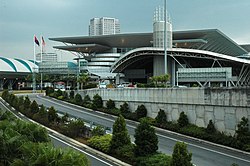A border checkpoint is a location on an international border where travelers or goods are inspected and allowed (or denied) passage through. Authorization often is required to enter a country through its borders. Access-controlled borders often have a limited number of checkpoints where they can be crossed without legal sanctions. Arrangements or treaties may be formed to allow or mandate less restrained crossings (e.g. the Schengen Agreement). Land border checkpoints (land ports of entry) can be contrasted with the customs and immigration facilities at seaports, international airports, and other ports of entry.
Contents
- Definitions in European Union (Schengen) law
- Busiest checkpoints in the world
- Land
- Air
- Sea
- Gallery
- See also
- Notes
- References
Checkpoints generally serve two purposes:
- To prevent entrance of individuals who are either undesirable (e.g. criminals or others who pose threats) or simply unauthorized to enter.
- To prevent entrance of goods that are illegal or subject to restriction, or to collect tariffs.
Checkpoints are usually staffed by a uniformed service (sometimes referred to as customs service or border patrol agents).
In some countries (e.g. China) there are border checkpoints for both those entering and those exiting the country, while in others (e.g. U.S. and Canada), there are border checkpoints only when entering the country.
















